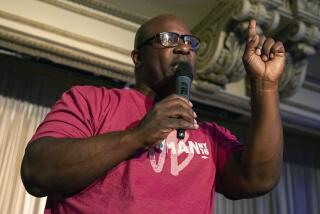No longer your father’s electorate
WASHINGTON — Even more than the election that made Barack Obama the first black president, the one that returned him to office sent an unmistakable signal that the hegemony of the straight white male in America is over.
The long drive for broader social participation by all Americans reached a turning point in the 2012 election, which is likely to go down as a watershed in the nation’s social and political evolution — and not just because in some states voters approved of same-sex marriage for the first time.
On Tuesday, Obama received the votes of barely 1 in 3 white males. That too was historic. It almost certainly was an all-time low for the winner of a presidential election that did not include a major third-party candidate.
“We’re not in the ‘50s any more,” said William Frey, a Brookings Institution demographer. “This election makes it clear that a single focus directed at white males, or at the white population in general, is not going to do it. And it’s not going to do it when the other party is focusing on energizing everybody else.”
Exit poll data, gathered from interviews with voters as they left their polling places, showed that Obama’s support from whites was 4 percentage points lower than in 2008. But he won by drawing on a minority-voter base that was 2 percentage points larger, as a share of the overall electorate, than four years ago.
The president built his winning coalition on a series of election-year initiatives and issue differences with Republican challenger Mitt Romney. In the months leading up to the election, Obama announced his support for same-sex marriage, unilaterally granted a form of limited legalization to young illegal immigrants and put abortion rights and contraception at the heart of a brutally effective anti-Romney attack ad campaign.
The result turned out to be an unbeatable combination: virtually universal support from black voters, who turned out as strongly as in 2008, plus decisive backing from members of the younger and fast-growing Latino and Asian American communities, who chose Obama over Romney by ratios of roughly 3 to 1. All of those groups contributed to Obama’s majority among women. (Gay voters, a far smaller group, went for Obama by a 54-point margin.)
“Obama lost a lot of votes among whites,” said Matt Barreto, a University of Washington political scientist. “It was only because of high black turnout and the highest Latino turnout ever for a Democratic president that he won.”
Obama planted his base in an America that is inexorably becoming more diverse. If left unchecked by Republicans, these demographic trends would give the Democrats a significant edge in future presidential elections.
Latinos were an essential element of Obama’s victories in the battlegrounds of Nevada and Colorado. States once considered reliably Republican in presidential elections will probably become highly competitive because of burgeoning Latino populations, sometimes in combination with large African American populations. North Carolina, where Obama won narrowly in 2008 and came close this time, is one. The Deep South state of Georgia is another. Texas and Arizona in the Southwest are future swing states — by 2020, if not sooner.
Besides demography, Obama had another edge: the voter-tracking operation that his campaign had built over the last six years, which generated increased turnout on Tuesday among young people and unmarried women.
“That was pure machinery. Hats off to them,” said Republican strategist Sara Taylor Fagen, who was a White House political aide under President George W. Bush. “Our party has a lot to learn and needs to invest very serious resources in improving our own machinery.”
The election was not an unblemished success for Democrats, who face a potentially serious threat from the loss of white votes.
“I don’t think you can be a major party and get down to support approaching only a third of the white population,” said Frey, the demographer. “In some ways, maybe, Obama dodged a bullet here. If the Republicans had made a little bit of an effort toward minorities and kept their focus on whites, they might have won.”
Paul Maslin, a Democratic pollster, said that with Obama having run his last race, “we’ll have demographics working for us, but it is not going to be so easy to keep it patched tight. It’s going to fray.”
Without Obama on the ticket, socially conservative African American voters might have been more inclined to follow the urgings of ministers who asked them to stay home to protest the Democrats’ endorsement of gay marriage.
But the Republican Party’s problems are more immediate, and much tougher to solve. Some GOP strategists have been warning for years about the risks of hitching the party’s fortunes to a shrinking share of the electorate.
Florida Sen. Marco Rubio, who combines a tea party pedigree with Latino heritage, said in a postelection statement that “the conservative movement should have particular appeal to people in minority and immigrant communities who are trying to make it, and Republicans need to work harder than ever to communicate our beliefs to them.”
Al Cardenas, a leading Republican fundraiser, said his party was “out of step with the demographic challenges of today.” Like Rubio, the Cuban-born Cardenas is close to former Florida Gov. Jeb Bush, who has long sought to broaden the GOP’s appeal to Latino voters and will be a prominent voice in the debate over the party’s future.
Romney’s chances ultimately depended on his ability to turn out a bigger white vote against Obama than Republican nominees received in earlier races. Eight years ago, Bush’s brother, President George W. Bush, defeated Democrat John F. Kerry by 17 percentage points among white voters and won reelection. Romney took the white vote by 20 percentage points and lost.
The difference: Despite an aggressive voter mobilization effort, the white share of the electorate has fallen to 72%, from 74% in 2008 and 77% in 2004.
Viewed narrowly, this week’s election essentially left Washington untouched. A Democratic president will continue to battle a divided Congress. Within the halls of the Republican-controlled House and the Democratic-led Senate, the balance of partisan power scarcely budged at all.
But pull back and a very different picture emerges. The civil rights, gay rights and women’s movements, designed to allow others to reach for power previously grasped only by white men, have made a real difference, and the outlines of 21st century America have emerged.
Times staff writer Maeve Reston contributed to this report from Boston.
More to Read
Get the L.A. Times Politics newsletter
Deeply reported insights into legislation, politics and policy from Sacramento, Washington and beyond. In your inbox three times per week.
You may occasionally receive promotional content from the Los Angeles Times.










